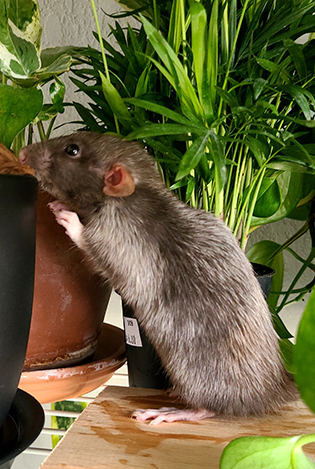BEHAVIOR
Rats are colony-style animals and are extremely social. While they do not have a strict social hierarchy like horses, they do have social placements similar to dogs. (Pack theory has been debunked for canines.) This means that newcomers have to find their place within the colony. This happens through wrestles, small tussles, and force grooming. Blood should never be drawn, but squeaks of protest are quite common.
Rats should be kept in, at minimum, pairs. However, science suggests that a trio is even more beneficial and less stressful than a pair.
Rats kept alone have been proven to have increased rates of aggression toward both other rats and humans, increased rates of depression, lowered immunity, shortened lifespans, and are prone to self mutilation. Male rats who exhibit aggression between the ages of 4 months to 1 year are, most commonly, victims of hormonal aggression. While this is most prevalent in cases of poor breeding, anomalies do occur even in well-bred lines. In most cases, a neuter for bucks will solve the issue. In does, we see hormonal aggression present via maternal aggression, which is when a previously sweet doe becomes aggressive or skittish anytime between conception and weaning age. These does can also be “bullies” in the main colony and will actively pick on and torment other members. Unfortunately, a spay will not work to curb this behavior unless it is only happening during an active heat.

Illnesses
Like all pets, rats have a list of common illnesses that pet owners are most likely to run into. Being prepared with an emergency kit, a reliable vet, and knowledge about these illnesses can help you plan.
Important Emergency Kit Supplies
- 1 ml & 10 ml syringes
- Sterile Saline
- Gauze
- Vet Wrap
- Vetericyn or other types of wound spray
- Kitchen scale
- Dark chocolate for temporary respiratory relief (60%+)
Some OTC medications can be used for short-term relief, but you should always consult your vet before attempting any at-home medicating.
All rats (except for a few lab strains) carry a type of bacteria called Mycoplasma Pulmonis. This strain of mycoplasma is species specific to rats and mice and cannot infect humans. This bacteria is the main culprit in most URIs. A “myco flare” can occur during times of stress, other illness, or can flare easier in rodents who are genetically prone to them. Not all medications target mycoplasma, but the most common (and effective treatment) is a combination of Baytril and Doxycycline. Amoxicillin, while commonly prescribed, does not target mycoplasma, but can prevent secondary infections from setting in.
The other form of URIs is caused by viral infections and is resistant to antibiotics.
Symptoms can include: excess porphyrin (red crust) around nose, ears, eyes, and mouth, fluffed fur, lethargy, and difficulty breathing. Rasping, wheezing, gasping, and crackling can also be heard in advanced URIs.
URIs fall into one of two categories: acute or chronic. Acute URIs are generally one-off infections in an otherwise healthy animal. Chronic URIs are recurring URIs that are generally progressive and deteriorate the animal’s health. More information on Mycoplasma and on chronic URIs can be found below.
An abscess is a pocket of pus under the skin, usually caused by a bacterial infection from a bite, scratch or other irritant. These lumps often appear “overnight” and grow rapidly. They often feel soft and fluid-filled and can be malodorous. Warm, wet compresses can be applied to the lump multiple times a day in short intervals to help the abscess burst and “come to a head.” Once the abscess has burst, the wound can be kept clean with sterile saline rinses and a product called Vetericyn. Do not use triple antibiotic ointment or hydrogen peroxide. These products can facilitate outside-in healing, which can trap leftover bacteria. Abscesses should heal inside-out. Below is more information on abscesses.
Ear infections are unfortunately quite common in rats, but are easily treatable. These infections can be caused by mycoplasma, Streptobacillus moniliformis and other types of viruses and bacteria. The most notable symptoms for an ear infection is a head tilt, often toward the infected ear. Other symptoms include lack of balance, walking in circles, and other common pain signals such as side sucking, fluffed fur and squinting. Treatment consists of 3-6 weeks of baytril, amoxicillin, doxycycline, chloramphenicol or azithromycin. More information on ear infections can be found below.
Ear infections are unfortunately quite common in rats, but are easily treatable. These infections can be caused by mycoplasma, Streptobacillus moniliformis and other types of viruses and bacteria. The most notable symptoms for an ear infection is a head tilt, often toward the infected ear. Other symptoms include lack of balance, walking in circles, and other common pain signals such as side sucking, fluffed fur and squinting. Treatment consists of 3-6 weeks of baytril, amoxicillin, doxycycline, chloramphenicol or azithromycin. More information on ear infections can be found below.
Ear infections are unfortunately quite common in rats, but are easily treatable. These infections can be caused by mycoplasma, Streptobacillus moniliformis and other types of viruses and bacteria. The most notable symptoms for an ear infection is a head tilt, often toward the infected ear. Other symptoms include lack of balance, walking in circles, and other common pain signals such as side sucking, fluffed fur and squinting. Treatment consists of 3-6 weeks of baytril, amoxicillin, doxycycline, chloramphenicol or azithromycin. More information on ear infections can be found below.
Fleas: Fleas can and will feed on rats if given the chance. However, since most rats are indoor dwelling animals, as long as other animals that go outside are up-to-date on their flea medication, it is not generally a huge worry. Signs of fleas include increased scratching, grooming, bald spots, and scabs. Fleas are visible to the naked eye.
Mites: The two main species of mite that feed on rats are Radfordia affinis. R. Ensiferum and Ornithonyssus bacoti. (Note: the latter species of mite can also infect humans and mice.) Symptoms include increased scratching, grooming, bald spots of fur, and scabs, primarily around the neck and ear area. Mites are generally very hard to see without help. Not all rats will show symptoms of mites even if they are present.
Lice: Lice are species-specific and it is Polyplax spinulosa. (Mice are P. Serrata.) Symptoms are identical to mites, but lice can be seen with the naked eye.
External parasites are most often brought in on bedding and food blocks. Freezing for 48 hours prior to use eliminates the risk of parasites.
Rats can also have the intestinal worms found in dogs and cats.
The most effective treatment is to dose with cat/kitten Revolution.

